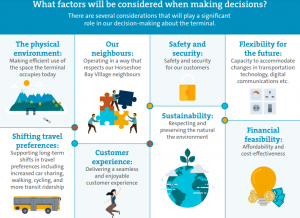Thinking Like a Designer
April 8, 2018 - 7 minutes readHow will people get around 20 years from now?
Answering this difficult question is part of the challenge BC Ferries is facing in redesigning one of their busiest ferry terminals, Horseshoe Bay. Ferries are usually an “in between” form of travel: rarely is the area immediately surrounding a ferry terminal the destination, and so, BC Ferries’ terminals must synergize with how people get to the departure terminal and leave from the arrival terminal.
Is large car capacity needed in the next generation of ferries to accommodate electric, autonomous vehicles, or are smaller, more pedestrian-focused ferries needed to serve as intermediaries for a public travelling almost exclusively by public transit? What terminal design can accommodate these different, and equally plausible visions? (Perhaps our obsession with travel will diminish and an interest in virtual reality will increase to such an extreme that ferries, and terminals, will get smaller and less busy with people living more sedentary, virtual lives. (Hopefully not, though I say that not yet being acquainted with the merits of virtual reality as it would be 20 years from now…))
Unlike a smartphone, which is somewhat nimble in adapting to new technologies (for a few years anyway), designing a ferry terminal intended to last decades is a little more of a commitment; especially the parts of the terminal made of concrete. How does one design something with such a lifespan?
BC Ferries is currently consulting with various stakeholders and trying to get a sense of what its passengers (commuters, domestic vacationers, foreign tourists) hope for and need from a redesigned terminal. When BC Ferries requested that students participate in the consultation process, we jumped at the chance: what a terrific, real-world, opportunity for students to apply their understanding of some aspects of the design process to share ideas with BC Ferries and also learn a little bit about what factors BC Ferries is considering in their redesign.
Embedded in the practical considerations of how the terminal will accommodate various vessels are ethical decisions: what is the most sustainable form of transportation both on the water (electric ferries coming soon?) and to and from terminals? How will the terminal be accessible for all passengers? And how will the terminal be respectful of its neighbours? Students have the opportunity to apply some of their learning from the Future City Project that students participated in earlier, where they imagined, researched, and designed, cities of the future that attempted to solve issues of sustainability and accessibility.
The BC Ministry of Education’s Applied Design, Skills and Technologies (ADST) Curriculum, touted for providing hands on learning opportunities such as sewing or woodworking, also provides opportunities for more abstract thinking, such as offering input on the design of a ferry terminal intended to accommodate, and seamlessly integrate with, several generations of transportation methods. Students will be submitting design ideas to BC Ferries which will be featured in some of the upcoming consultations they are doing with communities.
Opportunities to learn about real-world design are limited only by one’s initiative and capacity to think as a designer. A developed and deliberate method of observation can allow almost any object or system to be examined, both for its form and function. Another class at BICS, not engaged in the BC Ferries consultation but engaged in other aspects of the ADST curriculum throughout the year, is learning about universal design. They have been working with Javier Estebecorena of Hermanos Estebecorena Design Studio. Mr. Estebecorena is a designer and mechanical technician, and fortunately for our school, a parent of children at BICS. He has been volunteering his time with students to teach them design thinking, sharing his insights of universal design and assisting them to make observations based on functional, aesthetic, social and economic perspectives and to expand their responses to products and systems beyond simple judgements of like and dislike. His hope is that from their earliest learning, students think of design universally, in other words, they understand that the same principles and many of the same processes apply to all forms of design.
Mr. Estebecorena also hopes for students to feel empowered to be doers, to be more than just people who use things created by others, but become creators themselves, whether that be by creating physical items, or by creating ideas that challenge traditional perceptions or ways of doing. This is the essence of the ADST curriculum and I look forward to sharing more of this work in future blog posts as students continue to work with Mr. Estebecorena.
Mr. Estebecorena will also work with our Community School Coordinator, Sarah Haxby, on our “slug art” by designing eye-catching signage that encourages cars to slow down in the school zone. These designs will be featured as part of our Bike to School Week, May 28 – June 3.
BICS students are very engaged in the ADST curriculum, whether it be through creating (knitting, sewing, some classes even doing woodworking) or thinking like a designer in order to understand complex systems and propose solutions to some of the challenges we face. In a variety of ways, the ADST curriculum is proving to be one of the most interesting additions to BC’s revised curriculum and aspects of this curriculum will be featured in future blog posts.

0 Comments